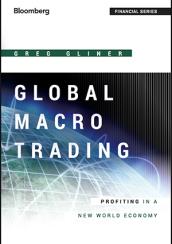The title of Greg Gliner’s new book, Global Macro Trading: Profiting in a New World Economy, is misleading. A better title might have been Macro Encyclopedia. With a meticulous outline of the analytical techniques and risk management methods that global macro portfolio managers commonly use, Gliner has created a solid reference tool for the investment community. Along with its clear, easy-to-digest language served in bite-size portions, the book’s logically laid-out chapters make it easy to flip to specific sections. Global Macro Trading is under publisher John Wiley & Sons’ Bloomberg Financial imprint and, accordingly, has the added advantage of providing shortcuts to the Bloomberg terminal functions that correspond to specific topics.
The book goes beyond being purely a manual for traders; the information on global macro risk could be of benefit to stock pickers, institutional sales representatives, equity analysts, pension consultants and wealth managers alike. This is not a textbook, however, and there is very little in the way of mathematical explanation.
Gliner, an industry veteran who has held various investment positions, including at hedge fund firms AQR Capital Management (see AQR co-founder Cliff Asness’s piece, “The Great Divide over Market Efficiency”) and Tudor Investment Corp., brings an insider’s voice. The book opens with a rundown of risk management methodologies, quantitative analysis techniques and the deployment of systematic trading. The discussion of technical analysis is entirely neutral, explaining the primary methodologies for the uninitiated while at the same time sidestepping controversy by laying out all arguments for and against the approach. Gliner takes the high road with respect to risk management as well when he describes the merits of Sharpe and Sortino ratios as a tool for measuring portfolio risk. For example, in his outline of systematic macro trading strategies, Gliner quickly summarizes the academic underpinnings for the investment approach in question before explaining each primary strategy in brief paragraphs. Each section references books and research papers by luminaries to help direct readers who want to delve deeper into a given topic.

|
A major shortcoming of the book is that, in its efforts to move quickly from topic to topic, it tends to gloss over some explanations that could be beneficial. For example, when describing the close relationship between the value of the Australian dollar versus the U.S. dollar and the VIX measure of volatility, there is no discussion of potential drivers of divergence between the two indicators. As such, an investor cannot glean sufficient information from any section of the book to ever make a specific investment decision. But ultimately, that isn’t the point of the book, despite the title’s suggestion that it will show readers how to “profit.” It only provides the view from 5,000 feet.
Another unavoidable weakness of the book is that, by definition, it will require regular updates. Macro investment strategies evolve constantly, and some economic developments covered by Gliner today might not be as relevant in the mid- to long term. Still, it’s likely that future editions will be of use to any investor who wants a thorough macro handbook.
Get more on macro.






